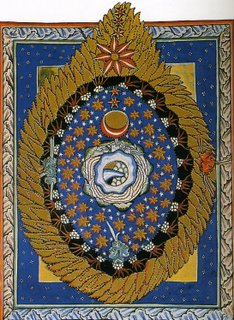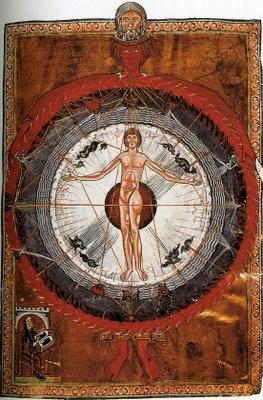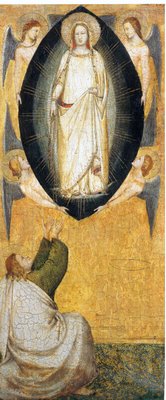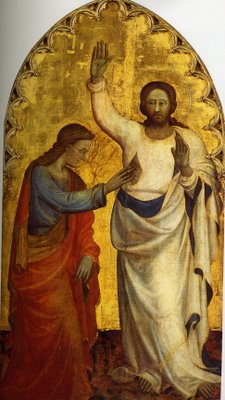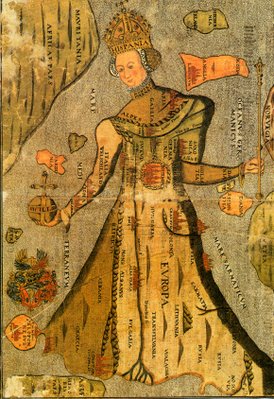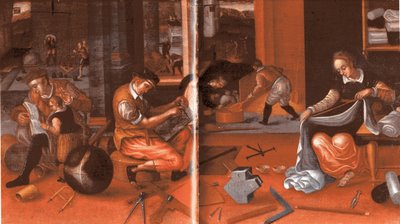
O fresco retrata a Ascensão de Cristo, levando consigo para os céus uma multidão de Anjos, santos e homens.
É interessante saber que Maso di Banco trabalhou com Giotto, de quem foi discípulo e do qual talvez tenha recebido a ideia ou mesmo a ordem de pintar a Virgem entregando o seu cinto a Tomé, o apóstolo incrédulo, no momento da Ascensão.
Continuando aqui a ler a Legenda Aurea de Voragine, cita-se São Bernardo a propósito da Ascensão de Cristo e de como ela significou a redenção da humanidade :
" O Senhor... fê-lo sentar-se à direita da sua glória, como co-iguais na glória, consubstanciais na essencia, consemelhantes pela geração, não diferentes pela majestade, e sem que nenhum deles fosse posterior ao outro na eternidade..."
E ainda, o mesmo S. Bernardo:
" Homem, tens um acesso seguro até Deus, onde a Mãe está diante do Filho e o Filho está diante do Pai, a Mãe mostra ao Filho o peito e o seio, e o Filho mostra ao Pai o lado e as chagas.Portanto, onde há tantos sinais de amor, não pode haver qualquer recusa".
A função de Cristo é a de ser advogado dos homens junto do Pai, como lembra S.João, na sua primeira carta,cap.2: Temos um advogado junto do Pai, Jesus Cristo, o Justo, que é propiciação pelos nossos pecados".
Tal como o primeiro Adão é dito ter aberto as portas do Inferno, o segundo, que é Cristo, abrirá as portas do Paraíso. Acrescenta Santo Agostinho, a este propósito: " Senhor, prepara o que preparas. Na verdade, preparas-nos para Ti e preparas-Te para nós; quando preparas o lugar, não só o preparas em nós para Ti, mas também em Ti para nós".
Muito haverá a meditar sobre este fresco e o seu significado, mantendo se possível a pureza de expressão de uma fé absoluta, entregue, sem que nenhuma dúvida perturbe a íntima convicção. Da convicção faz parte um conceito complexo, que transparece nas citações de S.Bernardo e de Santo Agostinho : a de que Jesus é MEDIADOR entre os dois mundos, o divino e o humano, tal como veremos na pintura de Maso, evocando a Virgem dando o cinto a Tomé, fazendo desse gesto simbólico e complexo uma outra forma, ou a mesma, de MEDIAÇÃO entre o divino e o humano.
Erwin Panofsky, nos Studies in Iconology, humanistic themes in the Art of the Renaissance ( reed.1972 ) - obra que recomendo, dedica um capítulo ao movimento neo-platónico em Florença e no norte de Itália ( pp.129 e segs.)
O movimento neo-platónico, que em Itália floresceu pela mão de Marsilio Ficino na sua Academia de Florença, elaborava de forma sofisticada a doutrina do Amor fazendo de Platão um objecto de culto, entre o social e o místico e religioso.
Nas palavras de Panofsky a sociedade que se reunia na Academia funcionava de modo informal, convivial como se de um clube se tratasse, mas onde ao mesmo tempo se debatiam ideias e apresentavam investigações próprias de seminário, ou seitas ( iniciáticas ). Nesta Academia um outro sábio, Pico della Mirandola ( que tinha um sobrinho alquimista) veio alargar os horizontes culturais do grupo com matérias e fontes trazidas do Oriente.
É sabido que desde o século II da era cristã, em Alexandria, no Egipto, um grande foco de sabedoria mágica, química, alquímica, parte dela condensada no Corpus Hermeticum, circulava e desafiava a imaginação dos espíritos mais cultos. Ficino traduziu para latim os documentos originais do platonismo, a saber, Platão, mas também Plotino, Proclus, Porfírio, Jamblico, e outros, entre eles os textos atribuídos a Hermes Trismegistos ( Corpus Hermeticum ) e a Orfeu.Feitas as traduções o que Ficino tentou de ainda mais importante foi a conciliação destas doutrinas com a religião cristã, procurando um todo coerente que pudesse ser apresentado como sistema : foi a sua Theologia Platonica.
Ficino concebe Deus como Plotino concebeu o Uno, dando um cariz panteísta a uma doutrina que deste modo se torna heterodoxa em relação à cristã, que não permite que se identifique o Criador com o mundo criado. Segundo Ficino, Deus criou o mundo " pensando o Seu próprio Eu", pois Nele o ser, o pensar e o querer são a mesma coisa. Deus inclui em Si o universo criado, embora este não o inclua a Ele.
Avançando num resumo rápido desta teoria do Amor, este seria um "circuitus spiritualis" de Deus para o mundo e do mundo para Deus, num círculo místico permanente e perfeito.
O amor é sempre desejo, embora nem todo o desejo seja amor. Só quando o desejo se dirige a um fim supremo se pode chamar amor. Esse fim supremo é a bondade divina que se manifesta na beleza, no Belo; e o amor é assim definido como "desejo de fruição do belo", desiderio di bellezza, nas palavras de Pico, citado por Panofsky.
No século XVI a obra de maior destaque como exposição da nova doutrina do amor segundo os neo-platonistas é da autoria de Leão Hebreu : Os Diálogos de Amor. Teve grande influencia no seu tempo, em poetas, artistas e pensadores.
Contudo as pinturas de Maso e de Giotto remetem para épocas anteriores, guardando semelhantes e arquetípicas noções, que no Humanismo e Renascimento vieram a florescer.
Refiro-me precisamente aos primeiros séculos da era cristã e à sabedoria mística e alquímica trazida pelos árabes para a Península e circulando a partir do séc. X, pelo menos, para o resto da Europa. Será precisamente nas ordens religiosas que essa cultura pemanece copiada, guardada sigilosamente, longe dos olhares curiosos dos profanos. Porque havia a noção do perigo da sua heterodoxia..São conhecidas muitas atribuições. Por exemplo a AURORA CONSURGENS de S. Tomás de Aquino, que ele terá ditado já em leito de morte, parece ser uma compactação dos textos de Senior ( Ibn Umail, de quem já falei noutros posts ) e do Cântico dos Cânticos. Aqui se faz a celebração de um amor que é místico e alquímico, pois a Pedra Filosofal é dita num dos seus nomes secretos como Virgem, ou como Leite Virginal na sua primeira fase de transmutação.
Deixo a pergunta: terá o discípulo de Giotto, Maso di Banco, ocultamente comungado destas ideias, terá ele entendido ou tido as visões da Mediação do Amor, a vivência do supremo desejo do Belo ?
Contemplar os seus quadros é de verdade o que nos resta.
Um pouco mais de leitura: Edgar Wind, Mystères Paiens de la Renaissance ( trad. Gallimard,1992 )



